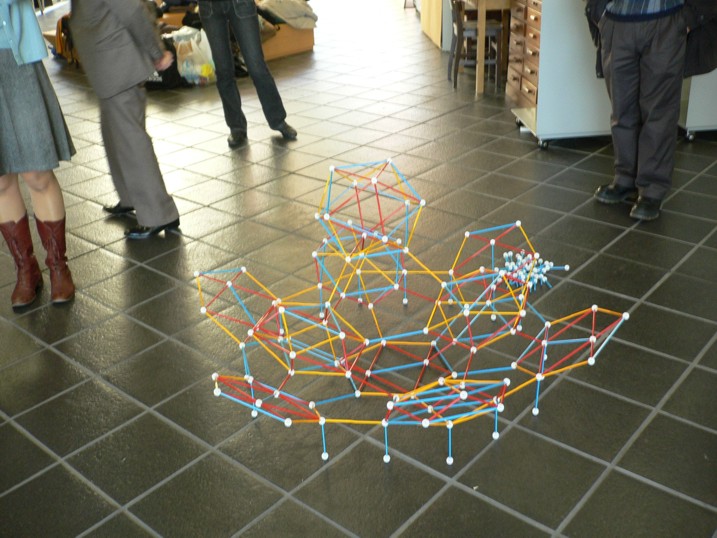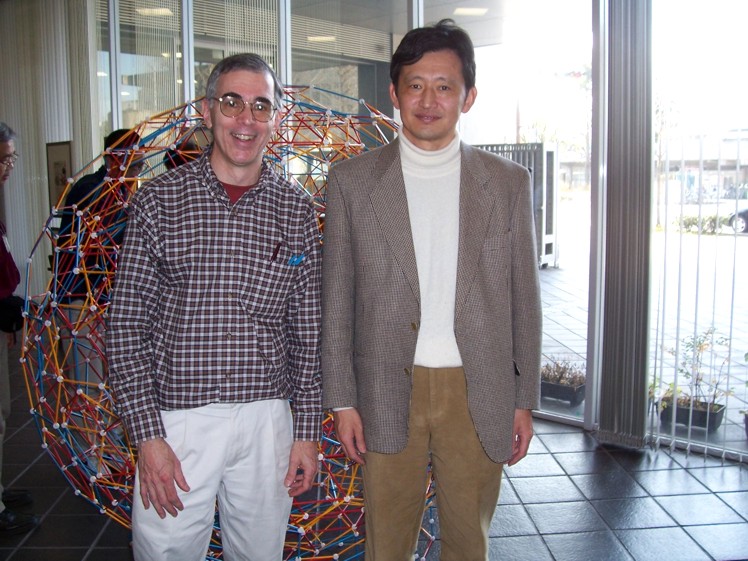In January 2008, I spent two wonderful weeks in Kyoto, as a guest of the Japan Society for the Promotion of Science. I am very grateful to the Society and to Professor Koji Miyazaki and to Professor Hideki Tsuiki for inviting me to come and for making many excellent arrangements. I am also grateful to Professor Terufumi Ohno of
Above, you can see participants starting the workshop, getting familiar with the Zometool components. Initially, everyone makes a regular icosahedron for practice, even though only one is needed in the final structure.
Now we are making more complex
icosahedra which are compressed relative to regular icosahedra. Ninety
modules are required all together, so it is great to have many people
working together.
Above, we have built many of the modules. Five different shapes are required. We count them and put them aside until it is time to assemble them.

I had initially tried to start at the center and work outwards, but the structure was very fragile. So we replanned and started assembling from the bottom up.
As it grows, people can work from all sides. It can be understood as a central core surrounded by four layers of icosahedra. Each layer is more flattened. The outermost layer of thirty icosahedra is completely flat.
The second workshop at the museum was to make a sculpture out of CDs connected with tie wraps. The shape is based on a truncated icosahedron. We made two copies of it and hung them up on display. We cut off the protruding tie wraps of the one on the left, but the one on the right we kept "hairy".
This workshop begins by making a ring of ten CDs Five are colored and face outwards. They correspond to the vertices of the truncated icosahedron. Five others, which correspond to the edges of the truncated icosahedron, face inwards. Twelve of these modules are required for one sculpture.
We start to assemble the modules and
hang them up so we can work around
them from all sides.
We continue adding modules and connecting them to each other, working downwards from the top. There are six colors used for this sculpture, with opposite modules being the same color. In the background above, you can see a drawing which we made before the assembly, to learn its structure.
At the same time, we work on a second sculpture which has the same form. There are 150 CDs and 180 tie wraps in each sculpture.
The final result is very shiny and attractive, but it will not last long. The CDs will soon crack from the bending. So this is a fun educational activity, but it does not make a permanent sculpture. For more information about this construction, see my paper on p. 205 in the ISAMA 2007 Proceedings.
Some of the photos above were taken by Kenji Nagai of the Japan Zome Club. There is a report (in Japanese) with more photos here. An article about the CD workshop was printed the next day in the Kyoto section of the newspaper Asahi Shimbun. You can see it on my citations page.
Other Photos
I gave a talk at Kyoto University in the clock tower that is behind this tree, which symbolizes the university.
I had wonderful meals with wonderful people.
I saw this interesting sangaku.
Thank you Koji Miyazaki.

Thank you Hideki Tsuiki.